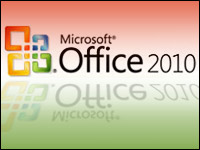
Microsoft launched Office 2010 and SharePoint 2010 for business customers Wednesday morning in an event held in New York City.
Office 2007, the last version of Microsoft’s cash cow — Office represents 25 percent of Microsoft’s annual revenue — came out four years ago. Office 2010 offers a plethora of new or upgraded features and functions focusing on productivity, collaboration and social media. In acknowledgment of its growing online competition, Microsoft is also offering a free online version, Office Web Apps, which includes some of Office 2010’s basic features. It will be made available for consumers later this summer.
Office 2010’s main tie-in to social media is through the Outlook Social Connector feature, which debuted in Office 2010’s beta last year. Among other functions, it connects emails, contact information and networking sites within the Outlook application.
Much of what is contained in Office 2010 has been tinkered with and discussed in the media, on tech sites and user forums during the beta testing period, which lasted for several months. The beta was downloaded by 8.6 million users.
For instance, the rehabbed Ribbon feature in Office 2010 garnered a wide number of reviews, many of them favorable. Essentially, it has been redesigned into a series of tabs to make it easier to navigate Office features.
That said, users shouldn’t let conventional wisdom or public opinion dictate their “favorite” features in Office 2010, Michael Cherry, an analyst with Directions on Microsoft, told the E-Commerce Times.
There are so many products that make up Office — from Word, Excel to PowerPoint — and within each product there are so many features that it becomes a very personal choice of what is “best,” or “most competitive” in Office 2010, he said.
The Little Things
Many of Cherry’s personal favorites in the upgraded application are little things that make using Office easier. A feature called “Backstage” makes it much easier to find a document on which you have recently worked, he noted.
Office 2010 has also updated its print function to give the user a preview of all the decisions that need to be made before printing a document — such as how many pages will be printed and with what margins, etc.
“Before, it took several dialogue boxes to get those questions answered,” said Cherry.
A similar enhancement to the paste function gives users a preview of what a document will look like after paste has been executed.
“Again, little things,” Cherry said, “but they make working with Office so much easier.”
Not all of the new or upgraded features get his blessing. “I am not a big fan of the Ribbon. It is not necessarily intuitive with all of the features, such as the insert options.”
Betwixt and Between
People are trying to pigeonhole the magnitude of the changes in Office 2010, Laura DiDio, principal with ITIC, told the E-Commerce Times. “Some say they are minor, others say it is a major overhaul.”
In DiDio’s opinion, the importance of the changes falls between those two extremes.
“Microsoft has cleaned up a lot of its earlier features that needed it and made the user experience that much better,” she pointed out, adding that it has also significantly boosted the security of the application.
However, while Office 2010 is not introducing a huge number of groundbreaking features, that doesn’t discount its importance for Microsoft at this point in time.
“Microsoft is under significant pressure to not just deliver a good product but to also respond to Google and Open Office,” DiDio said.
For Redmond, it has become a game of high-stakes poker, according to DiDio. “Microsoft has to keep raising the level of feature functions and performance — but at a price point the market will bear. This is not 1990 or 1995. Companies are cutting back, and some will find that Google’s offerings supply adequate functionality for a fraction of the cost.”
Hence the soon-to-launch Microsoft Office Web Apps, the online companions to Word, PowerPoint, Microsoft Excel and OneNote. These allow a document to be viewed online or from a mobile phone with the same appearance as the PC-based document.
Microsoft is releasing Web Apps in phases, Matt Roseoff, an analyst with Directions on Microsoft, told the E-Commerce Times. On Wednesday, Web Apps for corporate users were released, which require Sharepoint 2010. On June 15, Redmond is releasing a consumer version that can be accessible through Windows Live.
That is the offering most likely to go head-to-head with Google Apps, said Roseoff, although which will ultimately “win” with consumers remains to be seen, as each offers its own advantages and disadvantages.
Marketing and Advertising
The boxed software is scheduled to be available through retailers in several weeks — and Microsoft should precede the release with a heavy marketing and advertising campaign, DiDio said.
“Microsoft has to create a buzz around this product and help people differentiate it from other offerings on the market,” she remarked.
Volume licensing and software assurance companies are getting it now, but for other companies and consumers, Microsoft has to be ready with an answer to the question “why should I get this now when I can keep on using Google Apps for free?” she emphasized. “Google is there waving the free flag — so it is incumbent on Microsoft to knock this one out of the park in terms of sales.”
Between now and its June 15 retail release, “look for big promotions, rebates and possible discounts for the first 30 to 60 days it is on the shelves,” DiDio said.
Microsoft is retailing Office 2010 for US$499, or $399 with a product key card. The Home and Student version is retailing for $149.99; Home and Business for $279.99.























































Social Media
See all Social Media